工程光学练习题(英文题加中文题含答案)
工程光学练习题与解答
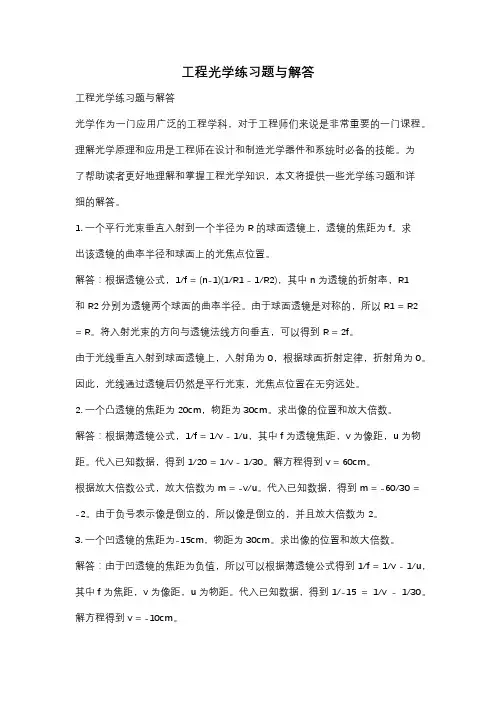
工程光学练习题与解答工程光学练习题与解答光学作为一门应用广泛的工程学科,对于工程师们来说是非常重要的一门课程。
理解光学原理和应用是工程师在设计和制造光学器件和系统时必备的技能。
为了帮助读者更好地理解和掌握工程光学知识,本文将提供一些光学练习题和详细的解答。
1. 一个平行光束垂直入射到一个半径为R的球面透镜上,透镜的焦距为f。
求出该透镜的曲率半径和球面上的光焦点位置。
解答:根据透镜公式,1/f = (n-1)(1/R1 - 1/R2),其中n为透镜的折射率,R1和R2分别为透镜两个球面的曲率半径。
由于球面透镜是对称的,所以R1 = R2 = R。
将入射光束的方向与透镜法线方向垂直,可以得到R = 2f。
由于光线垂直入射到球面透镜上,入射角为0,根据球面折射定律,折射角为0。
因此,光线通过透镜后仍然是平行光束,光焦点位置在无穷远处。
2. 一个凸透镜的焦距为20cm,物距为30cm。
求出像的位置和放大倍数。
解答:根据薄透镜公式,1/f = 1/v - 1/u,其中f为透镜焦距,v为像距,u为物距。
代入已知数据,得到1/20 = 1/v - 1/30。
解方程得到v = 60cm。
根据放大倍数公式,放大倍数为m = -v/u。
代入已知数据,得到m = -60/30 = -2。
由于负号表示像是倒立的,所以像是倒立的,并且放大倍数为2。
3. 一个凹透镜的焦距为-15cm,物距为30cm。
求出像的位置和放大倍数。
解答:由于凹透镜的焦距为负值,所以可以根据薄透镜公式得到1/f = 1/v - 1/u,其中f为焦距,v为像距,u为物距。
代入已知数据,得到1/-15 = 1/v - 1/30。
解方程得到v = -10cm。
根据放大倍数公式,放大倍数为m = -v/u。
代入已知数据,得到m = -(-10)/30 = 1/3。
由于负号表示像是倒立的,所以像是倒立的,并且放大倍数为1/3。
4. 一个平行光束垂直入射到一个半径为R的球面镜上,镜的焦距为f。
工程光学习题答案(附试题样本)
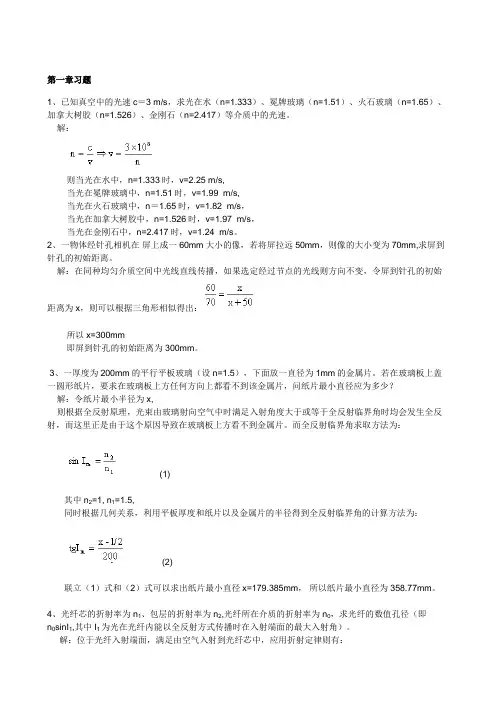
第一章习题1、已知真空中的光速c=3 m/s,求光在水(n=1.333)、冕牌玻璃(n=1.51)、火石玻璃(n=1.65)、加拿大树胶(n=1.526)、金刚石(n=2.417)等介质中的光速。
解:则当光在水中,n=1.333时,v=2.25 m/s,当光在冕牌玻璃中,n=1.51时,v=1.99 m/s,当光在火石玻璃中,n=1.65时,v=1.82 m/s,当光在加拿大树胶中,n=1.526时,v=1.97 m/s,当光在金刚石中,n=2.417时,v=1.24 m/s。
2、一物体经针孔相机在屏上成一60mm大小的像,若将屏拉远50mm,则像的大小变为70mm,求屏到针孔的初始距离。
解:在同种均匀介质空间中光线直线传播,如果选定经过节点的光线则方向不变,令屏到针孔的初始距离为x,则可以根据三角形相似得出:所以x=300mm即屏到针孔的初始距离为300mm。
3、一厚度为200mm的平行平板玻璃(设n=1.5),下面放一直径为1mm的金属片。
若在玻璃板上盖一圆形纸片,要求在玻璃板上方任何方向上都看不到该金属片,问纸片最小直径应为多少?解:令纸片最小半径为x,则根据全反射原理,光束由玻璃射向空气中时满足入射角度大于或等于全反射临界角时均会发生全反射,而这里正是由于这个原因导致在玻璃板上方看不到金属片。
而全反射临界角求取方法为:(1)其中n2=1, n1=1.5,同时根据几何关系,利用平板厚度和纸片以及金属片的半径得到全反射临界角的计算方法为:(2)联立(1)式和(2)式可以求出纸片最小直径x=179.385mm,所以纸片最小直径为358.77mm。
4、光纤芯的折射率为n1、包层的折射率为n2,光纤所在介质的折射率为n0,求光纤的数值孔径(即n0sinI1,其中I1为光在光纤内能以全反射方式传播时在入射端面的最大入射角)。
解:位于光纤入射端面,满足由空气入射到光纤芯中,应用折射定律则有:n0sinI1=n2sinI2 (1)而当光束由光纤芯入射到包层的时候满足全反射,使得光束可以在光纤内传播,则有:(2)由(1)式和(2)式联立得到n0 sinI1 .5、一束平行细光束入射到一半径r=30mm、折射率n=1.5的玻璃球上,求其会聚点的位置。
工程光学试卷
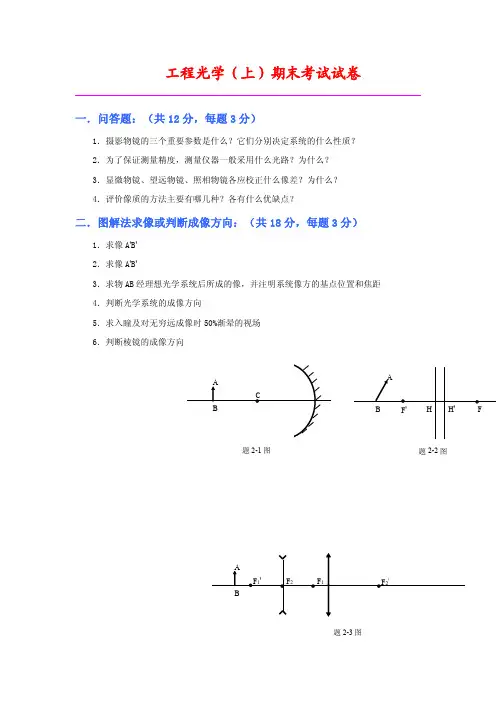
工程光学(上)期末考试试卷一.问答题:(共12分,每题3分)1.摄影物镜的三个重要参数是什么?它们分别决定系统的什么性质?2.为了保证测量精度,测量仪器一般采用什么光路?为什么?3.显微物镜、望远物镜、照相物镜各应校正什么像差?为什么?4.评价像质的方法主要有哪几种?各有什么优缺点?二.图解法求像或判断成像方向:(共18分,每题3分)1.求像A 'B '2.求像A 'B '3.求物AB 经理想光学系统后所成的像,并注明系统像方的基点位置和焦距4.判断光学系统的成像方向5.求入瞳及对无穷远成像时50%渐晕的视场6.判断棱镜的成像方向F 2题2-3图F 1F 1'F 2'ABCAB题2-1图F 'ABFHH '题2-2图三.填空:(共10分,每题2分)1.照明系统与成像系统之间的衔接关系为:①________________________________________________②________________________________________________2.转像系统分____________________和___________________两大类,其作用是:_________________________________________3.一学生带500度近视镜,则该近视镜的焦距为_________________,该学生裸眼所能看清的最远距离为_________________。
4.光通过光学系统时能量的损失主要有:________________________,zx y物镜题2-4图题2-5图Fzx y题2-6图________________________和_______________________。
5.激光束聚焦要求用焦距较________的透镜,准直要用焦距较________的透镜。
物理学:工程光学试题(题库版)
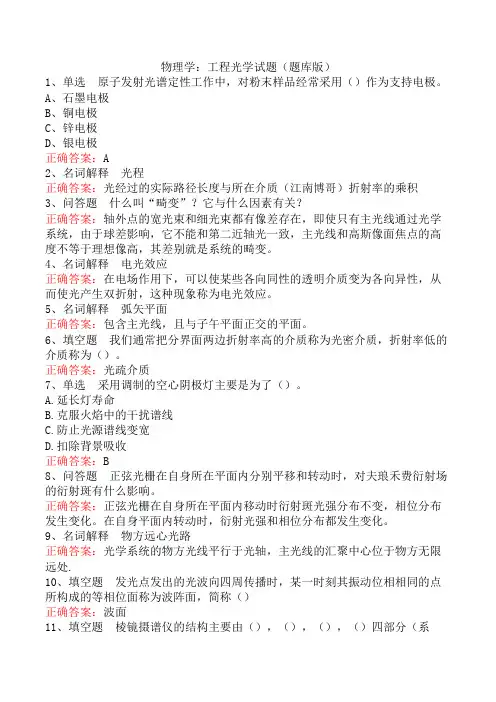
物理学:工程光学试题(题库版)1、单选原子发射光谱定性工作中,对粉末样品经常采用()作为支持电极。
A、石墨电极B、铜电极C、锌电极D、银电极正确答案:A2、名词解释光程正确答案:光经过的实际路径长度与所在介质(江南博哥)折射率的乘积3、问答题什么叫“畸变”?它与什么因素有关?正确答案:轴外点的宽光束和细光束都有像差存在,即使只有主光线通过光学系统,由于球差影响,它不能和第二近轴光一致,主光线和高斯像面焦点的高度不等于理想像高,其差别就是系统的畸变。
4、名词解释电光效应正确答案:在电场作用下,可以使某些各向同性的透明介质变为各向异性,从而使光产生双折射,这种现象称为电光效应。
5、名词解释弧矢平面正确答案:包含主光线,且与子午平面正交的平面。
6、填空题我们通常把分界面两边折射率高的介质称为光密介质,折射率低的介质称为()。
正确答案:光疏介质7、单选采用调制的空心阴极灯主要是为了()。
A.延长灯寿命B.克服火焰中的干扰谱线C.防止光源谱线变宽D.扣除背景吸收正确答案:B8、问答题正弦光栅在自身所在平面内分别平移和转动时,对夫琅禾费衍射场的衍射斑有什么影响。
正确答案:正弦光栅在自身所在平面内移动时衍射斑光强分布不变,相位分布发生变化。
在自身平面内转动时,衍射光强和相位分布都发生变化。
9、名词解释物方远心光路正确答案:光学系统的物方光线平行于光轴,主光线的汇聚中心位于物方无限远处.10、填空题发光点发出的光波向四周传播时,某一时刻其振动位相相同的点所构成的等相位面称为波阵面,简称()正确答案:波面11、填空题棱镜摄谱仪的结构主要由(),(),(),()四部分(系统)组成。
正确答案:照明系统;准光系统;色散系统;投影系统12、名词解释物方空间正确答案:所有实物点和虚物点的集合构成的空间。
13、填空题交流电弧的激发能力强,分析的重现性好,适用于(),不足的是蒸发能力也稍弱,灵敏度稍低。
正确答案:定量分析14、问答题什么是景深,照相物镜的景深与什么有关?正确答案:能在像面上获得清晰像的物空间的深度是系统的景深。
工程光学练习答案(带样题).doc
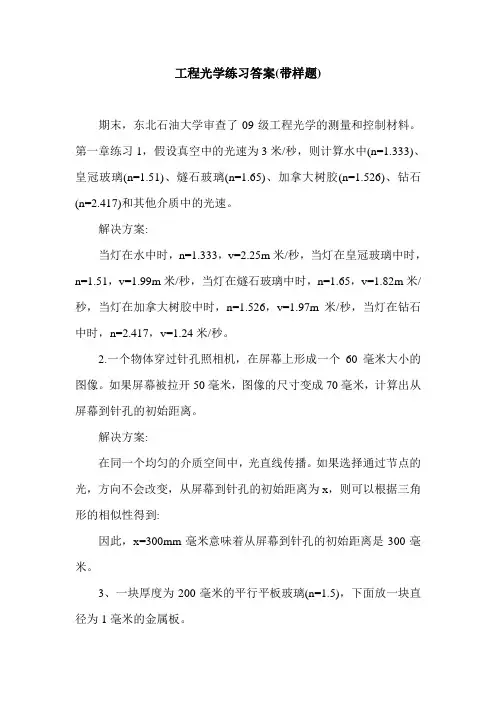
工程光学练习答案(带样题)期末,东北石油大学审查了09级工程光学的测量和控制材料。
第一章练习1,假设真空中的光速为3米/秒,则计算水中(n=1.333)、皇冠玻璃(n=1.51)、燧石玻璃(n=1.65)、加拿大树胶(n=1.526)、钻石(n=2.417)和其他介质中的光速。
解决方案:当灯在水中时,n=1.333,v=2.25m米/秒,当灯在皇冠玻璃中时,n=1.51,v=1.99m米/秒,当灯在燧石玻璃中时,n=1.65,v=1.82m米/秒,当灯在加拿大树胶中时,n=1.526,v=1.97m米/秒,当灯在钻石中时,n=2.417,v=1.24米/秒。
2.一个物体穿过针孔照相机,在屏幕上形成一个60毫米大小的图像。
如果屏幕被拉开50毫米,图像的尺寸变成70毫米,计算出从屏幕到针孔的初始距离。
解决方案:在同一个均匀的介质空间中,光直线传播。
如果选择通过节点的光,方向不会改变,从屏幕到针孔的初始距离为x,则可以根据三角形的相似性得到:因此,x=300mm毫米意味着从屏幕到针孔的初始距离是300毫米。
3、一块厚度为200毫米的平行平板玻璃(n=1.5),下面放一块直径为1毫米的金属板。
如果玻璃板上覆盖有圆形纸片,则要求玻璃板上方的任何方向都不能看到纸片。
这张纸的最小直径是多少?解决方案:如果纸片的最小半径是x,那么根据全反射原理,当光束从玻璃发射到空气中的入射角大于或等于全反射临界角时,就会发生全反射,正是由于这个原因,在玻璃板上方看不到金属片。
全反射的临界角由下式确定:(1)其中N2=1,n1=1.5,根据几何关系,利用平板的厚度和纸张与金属片的半径计算全反射临界角的方法如下:(2)纸张的最小直径x=179.385mm毫米可以通过组合等式(1)和(2)来获得,因此纸张的最小直径为358.77毫米4.光纤芯的折射率是n1.包层的折射率为n2,光纤所在介质的折射率为n0。
计算光纤的数值孔径(即n0sinI1,其中I1是光在光纤中以全反射模式传播时,光在入射端面的最大入射角)。
工程光学综合练习题
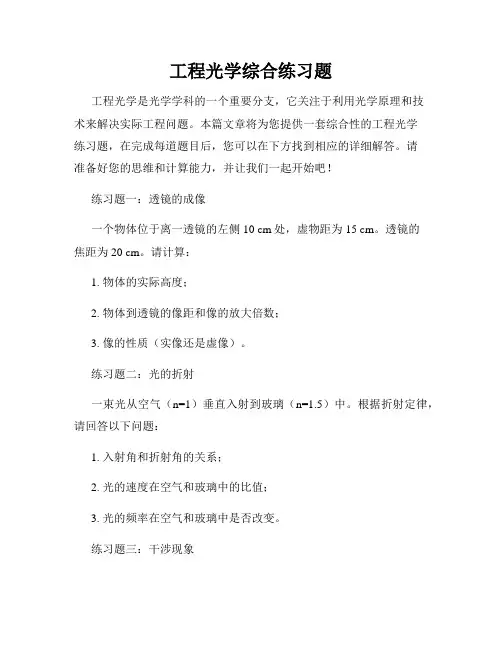
工程光学综合练习题工程光学是光学学科的一个重要分支,它关注于利用光学原理和技术来解决实际工程问题。
本篇文章将为您提供一套综合性的工程光学练习题,在完成每道题目后,您可以在下方找到相应的详细解答。
请准备好您的思维和计算能力,并让我们一起开始吧!练习题一:透镜的成像一个物体位于离一透镜的左侧10 cm处,虚物距为15 cm。
透镜的焦距为20 cm。
请计算:1. 物体的实际高度;2. 物体到透镜的像距和像的放大倍数;3. 像的性质(实像还是虚像)。
练习题二:光的折射一束光从空气(n=1)垂直入射到玻璃(n=1.5)中。
根据折射定律,请回答以下问题:1. 入射角和折射角的关系;2. 光的速度在空气和玻璃中的比值;3. 光的频率在空气和玻璃中是否改变。
练习题三:干涉现象两束相干光垂直入射到一个薄膜上,反射光和透射光的路径差为λ/4。
请回答以下问题:1. 反射光和透射光的相位差;2. 当反射光和透射光合成时,是否会发生干涉现象;3. 干涉程度与路径差的关系。
练习题四:光的偏振一束偏振光以45°的角度入射到一块偏振片上,通过该偏振片后,请回答以下问题:1. 出射光的偏振状态;2. 若将这束出射光再次入射到另一块偏振片上,且两片偏振片光轴垂直,求通过第二块偏振片的光的强度比原来的光强。
练习题五:光的衍射一束单色光通过一个狭缝后,发生衍射现象。
请回答以下问题:1. 产生衍射现象的必要条件;2. 当狭缝越窄时,衍射条纹的宽度是增大还是减小;3. 如何利用衍射现象来测量小孔的直径。
练习题六:激光技术激光在现代工程中有着广泛的应用。
请简要回答以下问题:1. 什么是激光,它与常规光有何不同之处;2. 列举至少三个激光应用的领域,并简述其原理;3. 激光在通信中的作用和优势是什么。
解答如下:练习题一:1. 物体的实际高度为10 cm。
2. 物体到透镜的像距为40 cm,像的放大倍数为1。
3. 像为实像。
练习题二:1. 入射角和折射角的关系由折射定律给出:n1sinθ1 = n2sinθ2,其中θ1为入射角,θ2为折射角,n1和n2分别为两种介质的折射率。
工程光学英文题加中文题含答案
English Homework for Chapter 11.In ancient times the rectilinear propagation of light was used to measure the height of objects by comparing the length of their shadows with the length of the shadow of an object of known length. A staff 2m long when held erect casts a shadow 3.4m long, while a building’s shadow is 170m long. How tall is the building?Solution. According to the law of rectilinear propagation, we get, x=100 (m)So the building is 100m tall.2.Light from a water medium with n=1.33 is incident upon a water-glass interface at an angle of 45o. The glass index is 1.50. What angle does the light make with the normal in the glass?Solution. According to the law of4.32170 xrefraction, We get,So the light makenormal in the glass.3. A goldfish swims 10cm from the side of a spherical bowl of water of radius 20cm. Where does the fish appear to be? Does it appear larger or smaller?Solution. According to the equation. and n ’=1 , n=1.33, r=-20we can getSo the fish appears larger.''sin sin I n I n =626968.05.145sin 33.1sin =⨯='I8.38='I rn n l n l n -'=-''11416.110133.15836.8)(5836.81165.02033.01033.11>-=⨯⨯-=''=-='∴-=--+-=-'+='l n l n cm l r n n l n l β n A4.An object is located 2cm to the left of convex end of a glass rod which has a radius of curvature of 1cm. The index of refraction of the glass is n=1.5. Find the image distance.Solution. Refer to the figure. According to the equationand n=1, n ’=1.5, l 1=-2cm,rn n l n l n -'=-''r 1=1cm , we getEnglish Homework for Chapter 21.An object 1cm high is 30cm in front of a thin lens with a focal length of 10cm. Where is the image? Verify your answer by graphical construction of the image. Solution. According toequation, and l=-30cm f ’we getOthers are omitted.cm l l d l l l 2021115.15.121211='∴-∞='-=∞='∴=-+-='f l l '=-'11)(15)30(10)30(10cm l f l f l =-+-⨯=+''='′′′2.A lens is known to have a focal length of 30cm in air. An object is placed 50cm to the left of the lens. Locate the image and characterize it.Solution.and f′=30cm l we getThe image is a real, larger one.3.The object is transparent cube, 4mm across, placed 60cm in front of 20cm focal length. Calculate the transverse and axial magnification and describe what the image looks like?Solution. From Gauss’s equation, we find for the rear surface of the cube (the face closer to the lens)that,f l l '=-'11(75)50(30)50(30l f l f l =-+-⨯=+''='5.15075-=-='=l l β)(3020)60()20()60(111cm f l f l l +=+-⨯-='+'='′For the front surface (the face farther away from the lens),The transverse magnification for the rear surface isBut the axial magnification isSince ,the cube doesn’t look likea cube.4.A biconvex lens is made out of glass of n=1.52. If one surface has twice the radius of curvature of the other, and if the focal length is 5cm, what are the two radii?Solution. Supposing r 1= -2r 2 (ρ2=-2ρ1),according to the lens equationwe get,∴r 1=7.8(cm) r 2=-3.9(cm))(9.29204.6020)4.60(2cm l +=+-⨯-='⨯-=-+=5.06030t M ⨯+=----=∆'∆=25.0)4.60(609.2930l l M a atM M ≠))(1(21ρρϕ--=n )(152.1(51ρ-=1282.01=∴ρ2564.02-=ρ返回English Homework for Chapter 4 1. A stop 8mm in diameter is placed halfway between an extended object and a large-diameter lens of 9cm focal length. The lens projects an image of the object onto a screen 14cm away. What is the diameter of the exit pupil?Solution. Refer to the figure. First, from the known focal length and the image distance,we find the object distance. and l ’=14 f ’=9l =-25.2(cm)The stop is one-half that distance is front of the lens, so l s =12.6(cm)∴l s ’=31.5(cm)∴2. Two lenses, a lens of 12.5cm focal length and a minus lens of unknownf l l '=-'11122.255.31-='==ss stop ex l l D D β )(28.05.2cm D ex=⨯=power, are mounted coaxially and 8 cm apart. The system is a focal, that is light entering the system parallel at one side emerges parallel at the other. If a stop 15mm in diameter is placed halfway between the lenses:1) Where is the entrance pupil?2) Where is the exit pupil?3) What are their diameters?’Solution. Refer to the figure. For thesystem to be a focal, the focal points of the two lenses mustcoincide. Since f 1’=12.5cm, and the two lenses are 8cm apart, so f 2’=-4.5cm. The entrance pupil is the image of stop formed by the first lens.According to Gauss’s equation,and l 1’=4cm, f 1’=12.5cm. We getThe exit pupil’slocation is返回111111f l l '=-'())(88.55.845.1211111cm l f l f l =⨯='-'''=)(05.22488.5151mm D D stopentrance =⨯==β)(95.715412.2)(12.25.818)4()5.4()4()5.4(222222mm D D cm f l l f l stop exit =⨯=∙=-=-=-+--⨯-='+'='βEnglish Homework for Chapter 71. A person wants to look at the image of his or her own eyes, without accommodation, using a concave mirror of 60cm radius of curvature. How far must the mirror be from the eye if the person has1) Normal vision?2) 4diopter myopia, without correction?3) 4diopter hyperopia, without correction?Solution.1) When the person has normal vision, according to the following scheme 1, we getso,∞='l cm r l 302==Scheme 1and, orSo the mirror must be 75cm or 10cmfrom the eye.and, or (Since the object isreal, so we can give up this answer)So the mirror must be 50cm from theeye.141-=m l r cm l l r 25-=='r l l 211=+' )(25cm l l +'=cm r 60=265852253048585025308522±=⨯⨯-±==⨯+-l l l ⎩⎨⎧==∴)(50')(7511cm l cm l ⎩⎨⎧-==)(15')(1022cm l cm l r l l 211=+' )(25'cm l l +=cm r 60=265352253043535025303522±=⨯⨯+±==⨯--l l l ⎩⎨⎧==∴)(75')(5011cm l cm l ⎩⎨⎧=-=)(10')(1522cm l cm l Scheme 2 Scheme 32. Discussion: What differences between the following situations:1) a microscope is used for projection;2) the microscope is used for visual observation.返回工程光学(上)期末考试试卷一.问答题:(共12分,每题3分)1.摄影物镜的三个重要参数是什么?它们分别决定系统的什么性质?2.为了保证测量精度,测量仪器一般采用什么光路?为什么?3.显微物镜、望远物镜、照相物镜各应校正什么像差?为什么?4.评价像质的方法主要有哪几种?各有什么优缺点?二.图解法求像或判断成像方向:(共18分,每题3分)1.求像A'B'2.求像A'B'3.求物AB经理想光学系统后所成的像,并注明系统像方的基点位置和焦距4.判断光学系统的成像方向5.求入瞳及对无穷远成像时50%渐晕的视场6.判断棱镜的成像方向三.填空:(共10分,每题2分)1.照明系统与成像系统之间的衔接关系为:①________________________________________________②________________________________________________2.转像系统分____________________和___________________两大类,其作用是:_______________________________ __________3.一学生带500度近视镜,则该近视镜的焦距为_________________,该学生裸眼所能看清的最远距离为_________________。
工程光学英文题加中文题含问题详解
English Homework for Chapter 11.In ancient times the rectilinear propagation of light was used to measure the height of objects by comparing the length of their shadows with the length of the shadow of an object of known length. A staff 2m long when held erect casts a shadow 3.4m long, while a building’s shadow is 170m long. How tall is the building?Solution. According to the law of rectilinear propagation, we get, 4.32170 x x=100 (m)So the building is 100m tall.2.Light from a water medium with n=1.33 is incident upon a water-glass interface at an angle of 45o. The glass index is 1.50. What angle does the light make with the normal in the glass?Solution. According to the law ofrefraction, We get,''sin sin I n I n =626968.05.145sin 33.1sin =⨯='οIο8.38='I So the light makenormal in the glass.3. A goldfish swims 10cm from the side of a spherical bowl of water of radius 20cm. Where does the fish appear to be? Does it appear larger or smaller?Solution. According to the equation. rn n l n l n -'=-'' and n ’=1 , n=1.33, r=-20we can get11416.110133.15836.8)(5836.81165.02033.01033.11>-=⨯⨯-=''=-='∴-=--+-=-'+='l n l n cm l r n n l n l βΘ So the fish appears larger.A4.An object is located 2cm to the left of convex end of a glass rod which has a radius of curvature of 1cm. The index of refraction of the glass is n=1.5. Find the image distance.Solution. Refer to the figure. According to the equationrn n l n l n -'=-'' and n=1, n ’=1.5, l 1=-2cm,r 1=1cm , we getcm l l d l l l 2021115.15.121211='∴-∞='-=∞='∴=-+-='English Homework for Chapter 21.An object 1cm high is 30cm in front of a thin lens with a focal length of 10cm. Where is the image? Verify your answer by graphical construction of the image. Solution. According toequation, f l l '=-'11 and l=-30cm f ’we get)(15)30(10)30(10cm l f l f l =-+-⨯=+''='Others are omitted.′2.A lens is known to have a focal length of 30cm in air. An object is placed 50cm to the left of the lens. Locate the image and characterize it.Solution.f l l '=-'11 and f′=30cm l we get (75)50(30)50(30l f l f l =-+-⨯=+''='5.15075-=-='=l l βThe image is a real, larger one.3.The object is transparent cube, 4mm across, placed 60cm in front of 20cm focal length. Calculate the transverse and axial magnification and describe what the image looks like?Solution. From Gauss’s equation, we find for the rear surface of the cube (the face closer to the lens)that,)(3020)60()20()60(111cm f l f l l +=+-⨯-='+'='′For the front surface (the face farther away from the lens),)(9.29204.6020)4.60(2cm l +=+-⨯-='The transverse magnification for therear surface is ⨯-=-+=5.06030t MBut the axial magnification is⨯+=----=∆'∆=25.0)4.60(609.2930l l M aSince atM M ≠,the cube doesn’t look likea cube.4.A biconvex lens is made out of glass of n=1.52. If one surface has twice the radius of curvature of the other, and if the focal length is 5cm, what are the two radii?Solution. Supposing r 1= -2r 2 (ρ2=-2ρ1),according to the lens equation))(1(21ρρϕ--=n we get,)(152.1(51ρ-=1282.01=∴ρ2564.02-=ρ∴r 1=7.8(cm) r 2=-3.9(cm)返回English Homework for Chapter 4 1. A stop 8mm in diameter is placed halfway between an extended object and a large-diameter lens of 9cm focal length. The lens projects an image of the object onto a screen 14cm away. What is the diameter of the exit pupil?Solution. Refer to the figure. First, from the known focal length and the image distance,we find the object distance. f l l '=-'111Θand l ’=14 f ’=9l =-25.2(cm)The stop is one-half that distance is front of the lens, so l s =12.6(cm) ∴l s ’=31.5(cm)22.255.31-='==ss stop ex l l D D βΘ∴)(28.05.2cm D ex=⨯=2. Two lenses, a lens of 12.5cm focal length and a minus lens of unknown power, are mounted coaxially and 8cm apart. The system is a focal, that is light entering the system parallel at one side emerges parallel at the other. If a stop 15mm in diameter is placed halfway between the lenses:1) Where is the entrance pupil?2) Where is the exit pupil?3) What are their diameters?Solution.Refer to the figure. For thesystem to be a focal, the focal points of the two lenses must coincide. Since f 1’=12.5cm, and the two lenses are 8cm apart, so f 2’=-4.5cm. The entrance pupil is the image of stop formed by the first lens.According to Gauss’s equation, 111111f l l '=-'and l 1’=4cm, f 1’=12.5cm. We get())(88.55.845.1211111cm l f l f l =⨯='-'''=)(05.22488.5151mm D D stopentrance =⨯==β The exit pupil’slocation is)(95.715412.2)(12.25.818)4()5.4()4()5.4(222222mm D D cm f l l f l stop exit =⨯=•=-=-=-+--⨯-='+'='β返回English Homework for Chapter 71. A person wants to look at the image of his or her own eyes, without accommodation, using a concave mirror of 60cm radius of curvature. How far must the mirror be from the eye if the person has1) Normal vision?2) 4diopter myopia, without correction?3) 4diopter hyperopia, without correction?Solution.1) When the person has normal vision, according to the following scheme 1, we get ∞='lso, cm r l 302== 141-=m l r cm l l r 25-==' Scheme 1r l l 211=+'Θ and )(25cm l l +'= cm r 60=265852253048585025308522±=⨯⨯-±==⨯+-l l l Θ ⎩⎨⎧==∴)(50')(7511cm l cm l , or ⎩⎨⎧-==)(15')(1022cm l cm lSo the mirror must be 75cm or 10cm from the eye.rl l 211=+'Θ and )(25'cm l l += cm r 60= 265352253043535025303522±=⨯⨯+±==⨯--l l l Θ ⎩⎨⎧==∴)(75')(5011cm l cm l , or ⎩⎨⎧=-=)(10')(1522cm l cm l (Since the object isreal, so we can give up this answer)So the mirror must be 50cm from the eye.Scheme 2 Scheme 32. Discussion: What differences between the following situations:1) a microscope is used for projection;2) the microscope is used for visual observation.返回工程光学(上)期末考试试卷一.问答题:(共12分,每题3分)1.摄影物镜的三个重要参数是什么?它们分别决定系统的什么性质?2.为了保证测量精度,测量仪器一般采用什么光路?为什么?3.显微物镜、望远物镜、照相物镜各应校正什么像差?为什么?4.评价像质的方法主要有哪几种?各有什么优缺点?二.图解法求像或判断成像方向:(共18分,每题3分)1.求像A'B'2.求像A'B'3.求物AB经理想光学系统后所成的像,并注明系统像方的基点位置和焦距4.判断光学系统的成像方向5.求入瞳及对无穷远成像时50%渐晕的视场6.判断棱镜的成像方向三.填空:(共10分,每题2分)1.照明系统与成像系统之间的衔接关系为:①________________________________________________②________________________________________________2.转像系统分____________________和___________________两大类,其作用是:_______________________________ __________3.一学生带500度近视镜,则该近视镜的焦距为_________________,该学生裸眼所能看清的最远距离为_________________。
第三版工程光学答案
第一章3、一物体经针孔相机在 屏上成一60mm 大小的像,若将屏拉远50mm ,则像的大小变为70mm,求屏到针孔的初始距离。
解:在同种均匀介质空间中光线直线传播,如果选定经过节点的光线则方向不变,令屏到针孔的初始距离为x ,则可以根据三角形相似得出:所以x=300mm即屏到针孔的初始距离为300mm 。
4、一厚度为200mm 的平行平板玻璃(设n =1.5),下面放一直径为1mm 的金属片。
若在玻璃板上盖一圆形的纸片,要求在玻璃板上方任何方向上都看不到该金属片,问纸片的最小直径应为多少?2211sin sin I n I n =66666.01sin 22==n I745356.066666.01c o s 22=-=I 88.178745356.066666.0*200*2002===tgI xmm x L 77.35812=+=8、.光纤芯的折射率为1n ,包层的折射率为2n ,光纤所在介质的折射率为0n ,求光纤的数值孔径(即10sin I n ,其中1I 为光在光纤内能以全反射方式传播时在入射端面的最大入射角)。
解:位于光纤入射端面,满足由空气入射到光纤芯中,应用折射定律则有:n0sinI1=n2sinI2(1)而当光束由光纤芯入射到包层的时候满足全反射,使得光束可以在光纤内传播,则有:(2)由(1)式和(2)式联立得到n.16、一束平行细光束入射到一半径r=30mm、折射率n=1.5的玻璃球上,求其会聚点的位置。
如果在凸面镀反射膜,其会聚点应在何处?如果在凹面镀反射膜,则反射光束在玻璃中的会聚点又在何处?反射光束经前表面折射后,会聚点又在何处?说明各会聚点的虚实。
解:该题可以应用单个折射面的高斯公式来解决,设凸面为第一面,凹面为第二面。
(1)首先考虑光束射入玻璃球第一面时的状态,使用高斯公式:会聚点位于第二面后15mm处。
(2)将第一面镀膜,就相当于凸面镜像位于第一面的右侧,只是延长线的交点,因此是虚像。
工程光学习题解答
第一章习题1、已知真空中的光速c=3m/s,求光在水(n=)、冕牌玻璃(n=)、火石玻璃(n=)、加拿大树胶(n=)、金刚石(n=)等介质中的光速。
?解:则当光在水中,n=时,v=m/s,当光在冕牌玻璃中,n=时,v=m/s,当光在火石玻璃中,n=时,v=m/s,当光在加拿大树胶中,n=时,v=m/s,当光在金刚石中,n=时,v=m/s。
2、一物体经针孔相机在屏上成一60mm大小的像,若将屏拉远50mm,则像的大小变为70mm,求屏到针孔的初始距离。
?解:在同种均匀介质空间中光线直线传播,如果选定经过节点的光线则方向不变,令屏到针孔的初始距离为x,则可以根据三角形相似得出:所以x=300mm?即屏到针孔的初始距离为300mm。
3、一厚度为200mm的平行平板玻璃(设n=),下面放一直径为1mm的金属片。
若在玻璃板上盖一圆形纸片,要求在玻璃板上方任何方向上都看不到该金属片,问纸片最小直径应为多少解:令纸片最小半径为x,则根据全反射原理,光束由玻璃射向空气中时满足入射角度大于或等于全反射临界角时均会发生全反射,而这里正是由于这个原因导致在玻璃板上方看不到金属片。
而全反射临界角求取方法为:(1)其中n2=1,n1=,同时根据几何关系,利用平板厚度和纸片以及金属片的半径得到全反射临界角的计算方法为:(2)联立(1)式和(2)式可以求出纸片最小直径x=179.385mm,所以纸片最小直径为358.77mm。
4、光纤芯的折射率为n1、包层的折射率为n2,光纤所在介质的折射率为n0,求光纤的数值孔径(即n0sinI1,其中I1为光在光纤内能以全反射方式传播时在入射端面的最大入射角)。
解:位于光纤入射端面,满足由空气入射到光纤芯中,应用折射定律则有:n0sinI1=n2sinI2(1)而当光束由光纤芯入射到包层的时候满足全反射,使得光束可以在光纤内传播,则有:(2)由(1)式和(2)式联立得到n0 sinI1.5、一束平行细光束入射到一半径r=30mm、折射率n=的玻璃球上,求其会聚点的位置。
- 1、下载文档前请自行甄别文档内容的完整性,平台不提供额外的编辑、内容补充、找答案等附加服务。
- 2、"仅部分预览"的文档,不可在线预览部分如存在完整性等问题,可反馈申请退款(可完整预览的文档不适用该条件!)。
- 3、如文档侵犯您的权益,请联系客服反馈,我们会尽快为您处理(人工客服工作时间:9:00-18:30)。
English Homework for Chapter 1ancient times the rectilinear propagation of light was used to measure the height of objects by comparing the length of their shadows with the length of the shadow of an object of known length. A staff 2m long when held erect casts a shadow long, while a building’s shadow is 170m long. How tall is the buildingSolution. According to the law of rectilinear propagation, we get, 4.32170=xx=100 (m)So the building is 100m tall.from a water medium with n= is incident upon a water-glass interface at an angle of 45o. The glass index is . What angle does the light make with the normal in the glassSolution. According to the law of refraction, We get,''sin sin I n I n =626968.05.145sin 33.1sin =⨯='I8.38='ISo the light make3. A goldfish swims 10cm from the side of a spherical bowl of water of radius 20cm. Where does the fish appear to be Does it appear larger or smaller Solution. According to the equation.r nn l n l n -'=-'' and n ’=1 , n=, r=-20we can get11416.110133.15836.8)(5836.81165.02033.01033.11>-=⨯⨯-=''=-='∴-=--+-=-'+='l n l n cm l r n n l n l βASo the fish appears larger.object is located 2cm to the left of convex end of a glass rod which has a radius of curvature of 1cm. The index of refraction of the glass is n=. Find the image distance.Solution. Refer to the figure. According to the equationr n n l n l n -'=-'' and n=1, n ’=, l 1=-2cm, r 1=1cm , we getcm l l d l l l 2021115.15.121211='∴-∞='-=∞='∴=-+-='English Homework for Chapter 2object 1cm high is 30cm in front of a thin lens with a focal length of 10cm. Where′is the image Verify your answer by graphical construction of the image. Solution. According to the Gauss’s equation,f l l '=-'11 and l=-30cm f ’=10 cm.we get)(15)30(10)30(10cm l f l f l =-+-⨯=+''='Others are omitted.lens is known to have a focal length of 30cm in air. An object is placed 50cm to the left of the lens. Locate the image and characterize it. Solution. According to Gauss’s equation,f l l '=-'11 and f′=30cm l =-50cmwe get)(75)50(30)50(30cm l f l f l =-+-⨯=+''='5.15075-=-='=l l βThe image is a real, larger one.object is transparent cube, 4mm across, placed 60cm in front of 20cm focal length. Calculate the transverse and axial magnification and describe what the image looks likeSolution. From Gauss’s equation, we find for the rear surface of the cube (the face closer to the lens)that,)(3020)60()20()60(111cm f l f l l +=+-⨯-='+'='For the front surface (the face farther away from the lens),)(9.29204.6020)4.60(2cm l +=+-⨯-='The transverse magnification for the rear surface is⨯-=-+=5.06030t M′′But the axial magnification is⨯+=----=∆'∆=25.0)4.60(609.2930l l M aSince a t M M ≠,the cube doesn’t look like a cube.biconvex lens is made out of glass of n=. If one surface has twice the radius of curvature of the other, and if the focal length is 5cm, what are the two radii Solution. Supposing r 1= -2r 2 (ρ2=-2ρ1),according to the lens equation))(1(21ρρϕ--=n we get, ))(152.1(5121ρρ+-=1282.01=∴ρ2564.02-=ρ∴r 1=(cm) r 2=(cm)返回English Homework for Chapter 41. A stop 8mm in diameter is placed halfway between an extended object and a large-diameter lens of 9cm focal length. The lens projects an image of the object onto a screen 14cm away. What is the diameter of the exit pupilSolution. Refer to the figure. First, from the known focal length and the image distance,we find the object distance.f l l '=-'111and l ’=14 f ’=9 l =(cm)The stop is one-half that distance is front of the lens, so l s =(cm) ∴l s ’=(cm)22.255.31-='==ss stop ex l l D D β∴)(28.05.2cm D ex =⨯=2. Two lenses, a lens of focal length and a minus lens of unknown power, are mounted coaxially and 8 cm apart. The system is a focal, that is light entering the system parallel at one side emerges parallel at the other. If a stop 15mm in diameter is placed halfway between the lenses: 1) Where is the entrance pupil 2) Where is the exit pupil 3) What are their diameters’Solution. Refer to the figure. For the system to be a focal, the focal points ofthe two lenses must coincide. Since f 1’=, and the two lenses are 8cm apart, so f 2’=. The entrance pupil is the image of stop formed by the first lens.According to Gauss’s equation, 111111f l l '=-' and l 1’=4cm, f 1’=. We get())(88.55.845.1211111cm l f l f l =⨯='-'''=)(05.22488.5151mm D D stopentrance =⨯==β The exit pupil’s location is)(95.715412.2)(12.25.818)4()5.4()4()5.4(222222mm D D cm f l l f l stop exit =⨯=•=-=-=-+--⨯-='+'='β返回English Homework for Chapter 71. A person wants to look at the image of his or her own eyes, without accommodation, using a concave mirror of 60cm radius of curvature. How far must the mirror be from the eye if the person has 1) Normal vision2) 4diopter myopia, without correction 3) 4diopter hyperopia, without correction Solution.1) When the person has normal vision, according to the following scheme 1, we get∞='lso,cm rl 302==2) According to the following scheme 2,141-=m l rcm l l r 25-=='r l l 211=+'and )(25cm l l +'= cm r 60=265852253048585025308522±=⨯⨯-±==⨯+-l l l ⎩⎨⎧==∴)(50')(7511cm l cm l , or⎩⎨⎧-==)(15')(1022cm l cm lSo the mirror must be 75cm or 10cm from the eye. 3) According to the following scheme 3,r l l 211=+'and )(25'cm l l += cm r 60=265352253043535025303522±=⨯⨯+±==⨯--l l l⎩⎨⎧==∴)(75')(5011cm l cm l , or ⎩⎨⎧=-=)(10')(1522cm l cm l (Since the object is real, so we can give upthis answer)So the mirror must be 50cm from the eye.Scheme 1Scheme 2Scheme 32. Discussion: What differences between the following situations:1) a microscope is used for projection;2) the microscope is used for visual observation.返回工程光学(上)期末考试试卷一.问答题:(共12分,每题3分)1.摄影物镜的三个重要参数是什么它们分别决定系统的什么性质2.为了保证测量精度,测量仪器一般采用什么光路为什么3.显微物镜、望远物镜、照相物镜各应校正什么像差为什么4.评价像质的方法主要有哪几种各有什么优缺点二.图解法求像或判断成像方向:(共18分,每题3分)1.求像A'B'2.求像A'B'3.求物AB经理想光学系统后所成的像,并注明系统像方的基点位置和焦距4.判断光学系统的成像方向5.求入瞳及对无穷远成像时50%渐晕的视场6.判断棱镜的成像方向三.填空:(共10分,每题2分)1.照明系统与成像系统之间的衔接关系为:①________________________________________________②________________________________________________2.转像系统分____________________和___________________两大类,其作用是:_________________________________________ 3.一学生带500度近视镜,则该近视镜的焦距为_________________,该学生裸眼所能看清的最远距离为_________________。
